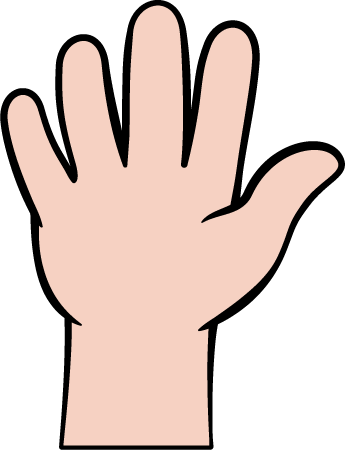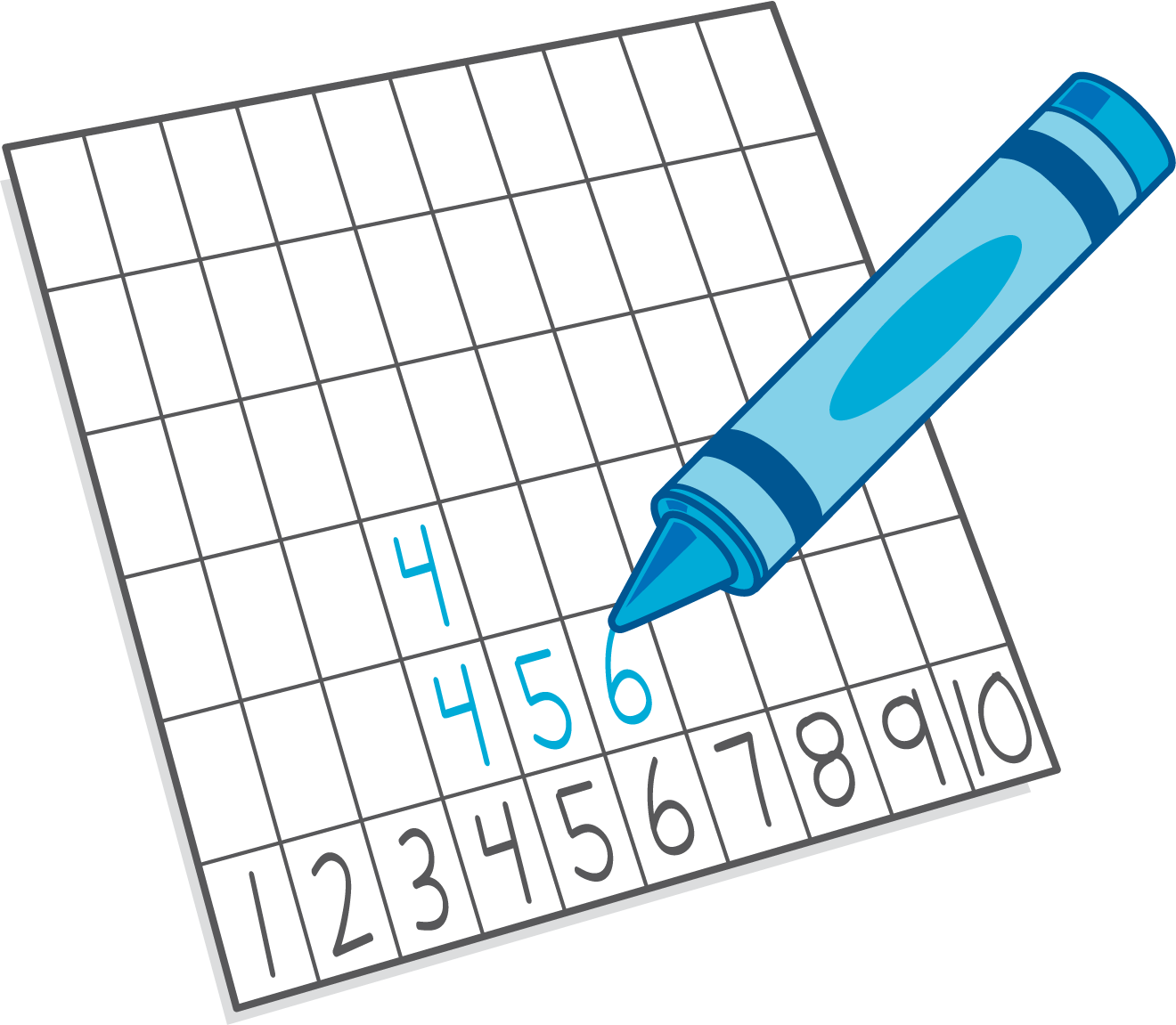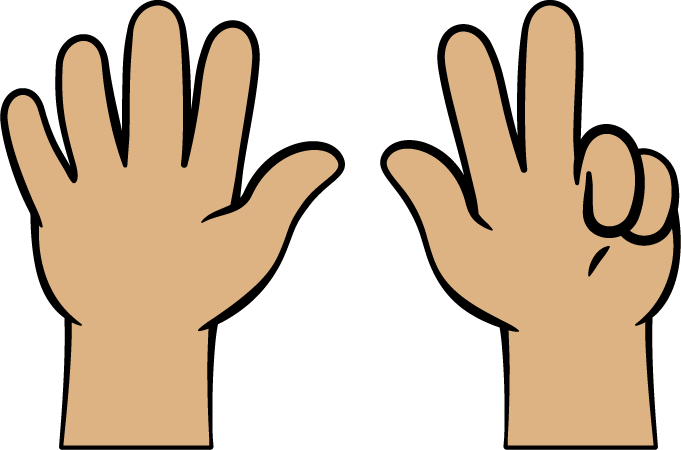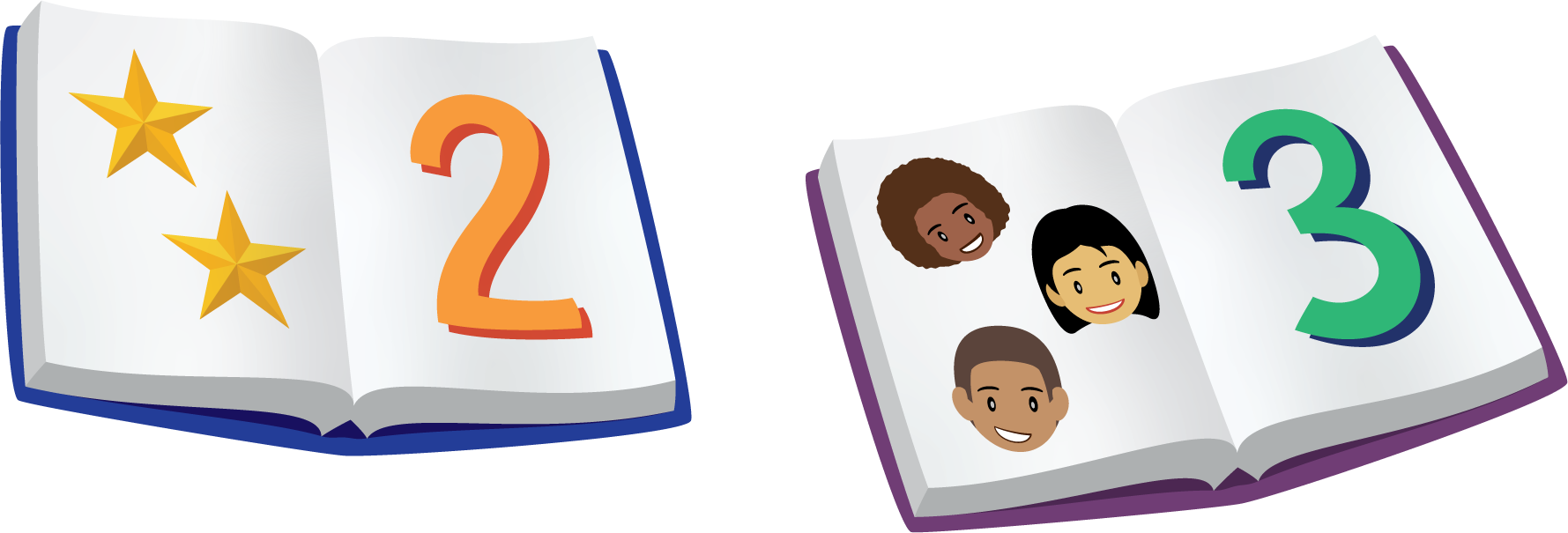Lesson 5
Make Groups of More, Fewer, or the Same
Warm-up: How Many Do You See: Fingers on Two Hands (10 minutes)
Narrative
The purpose of this How Many Do You See is for students to begin recognizing quantities represented on fingers without having to count. In this warm-up, students see numbers greater than 5, requiring 2 hands to represent. Students show the number with their fingers before answering, “How many do you see?" At this point, some students may still need to count, however with repeated exposure to quantities represented with fingers, they will begin to recognize numbers 1–10. As students make use of the structure of 5 fingers on each hand (MP7), they look for and express regularity in repeated reasoning through subitizing (MP8).
Launch
- Groups of 2.
- “How many do you see? How do you see them?”
- Display 5 fingers.

Activity
- “Discuss your thinking with your partner.”
- 30 seconds: partner discussion
- Share responses.
- “Use your fingers to show how many there are.”
- Repeat with 6 fingers and 7 fingers.


Student Response
For access, consult one of our IM Certified Partners.
Activity Synthesis
- “Work with your partner. One person show 6 with your fingers. One person show 7 with your fingers.”
- “Who is holding up fewer fingers? How do you know?” (The person with 6 fingers up is holding up fewer fingers. There is only 1 finger up on the extra hand.)
- “6 is less than 7.”
Activity 1: Introduce Less, Same, More, Groups of Objects (15 minutes)
Narrative
The purpose of this activity is for students to learn stage 1 of the Less, Same, More center. Students make groups that have fewer, the same, and more objects than a given group. Students choose a collection of objects and place all the objects at the top of the mat. They then make new groups that have fewer, the same, or more objects. To minimize the number of collections needed, have groups trade collections.
Supports accessibility for: Organization, Social-Emotional Functioning
Required Materials
Required Preparation
- Each group of 2 needs at least 2 collections of between 2 and 9 objects.
Launch
- Groups of 2
- Give each group a mat and access to collections of between 2–9 objects and connecting cubes.
- “Choose a group of objects and place them in the box at the top of the mat.”
- “Use cubes to make a new group of objects for each box below. Make a group that has fewer objects, a group that has the same number of objects, and a group that has more objects.”
- “Discuss with your partner how you know each group has more, fewer, or the same number of objects.”
Activity
- 10 minutes: partner work time
- Monitor for students who make different groups that have fewer objects than the given group. For example, if the given group has 7 objects, look for students who made different groups with fewer than 7 objects.
Activity Synthesis
- Display the mat with 7 cubes in the top box.
- Invite two previously identified students to demonstrate how they made groups with fewer objects.
- “Did both students make groups that have fewer than 7 objects?”
- “Let’s use the word fewer to describe the groups they made.”
- “5 cubes is fewer than 7 cubes.”
- “3 red cubes is fewer than 7 blue cubes.”
- “If I needed to make a group with the same number of objects as this group of 7 objects, what should I do?” (You should take out 7 cubes.)
Activity 2: Introduce Math Fingers, Fewer or More (15 minutes)
Narrative
The purpose of this activity is for students to learn stage 2 of the Math Fingers center. Students choose a card and one partner shows more fingers than the card while the other partner shows fewer fingers than the card. Students may count the fingers or recognize the quantity without counting. Students may also count on from 5 to determine how many fingers there are when 6–10 fingers are displayed.
Advances: Listening, Speaking, Representing
Required Materials
Materials to Copy
- Math Fingers Cards
Launch
- Groups of 2
- Give each group of students a set of cards.
- “We are going to learn a new way to play the Math Fingers center. Let’s play a round together.”
- Invite a student to act as the partner to demonstrate.
- “First we choose a card.”
- Flip over and display a card.
- “One partner shows fewer fingers than the fingers on the card. The other partner shows more fingers than the fingers on the card.”
- Show more fingers than the fingers on the card. Invite the student to shower fewer fingers than the fingers on the card.
- “Then you tell your partner how many fingers you are holding up. Tell them if there are more or fewer than the fingers on the card.”
- Demonstrate how to share with your partner.
- “I am showing 8 fingers. 8 fingers is more than 4 fingers.”
- “I am showing 2 fingers. 2 fingers is fewer than 4 fingers.”
- “When both partners agree that you showed a number that is more and a number that is fewer than the number on the card, choose a new card and take turns showing more fingers and fewer fingers.”
Activity
- 7 minutes: partner work time
Activity Synthesis
- Hold up 5 fingers.
- “Show fewer fingers than I am holding up. Share with your partner. Did you both hold up the same number of fingers?” (No, my partner held up three fingers and I held up one finger. We both held up fewer fingers.)
- “Show the same number of fingers that I am holding up. Share with your partner. Did you both hold up the same number of fingers?” (Yes, we both held up 5 fingers.)
Activity 3: Center: Choice Time (15 minutes)
Narrative
The purpose of this activity is for students to choose from activities that offer practice with number and counting concepts. Students choose from any stage of previously introduced centers.
- Less, Same, More
- Number Race
- Shake and Spill
- Math Fingers
- Pattern Blocks
- Picture Books
Required Materials
Materials to Gather
Required Preparation
- Gather materials from:
- Less, Same, More, Stage 1
- Number Race, Stage 1
- Shake and Spill, Stages 1 and 2
- Math Fingers, Stages 1 and 2
- Pattern Blocks, Stages 1-3
- Picture Books, Stages 1 and 2
Launch
- “Today we are going to choose from centers we have already learned. You can also choose to keep playing Less, Same, More or Math Fingers.”
- Display the center choices in the student book.
- “Think about what you would like to do first.”
- 30 seconds: quiet think time
Activity
- Invite students to work at the center of their choice.
- 10 minutes: center work time
Student Facing
Choose a center.
Less, Same, More

Shake and Spill

Number Race

Math Fingers

Pattern Blocks

Picture Books

Activity Synthesis
- “Today we played Math Fingers. How did you figure out how many fingers were on each card?” (I counted them. I could just see that there were 5 because all of the fingers on one hand were up.)
Lesson Synthesis
Lesson Synthesis
“Today we made groups that had more, fewer, or the same number of objects as a given group. We also learned two new centers. How did your partner help you today during center time? How did you help your partner?”
Cool-down: Unit 2, Section A Checkpoint (0 minutes)
Cool-Down
For access, consult one of our IM Certified Partners.